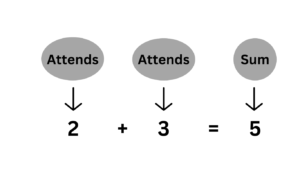Table of Contents
Introduction
Ah, basic addition – the humble building block of mathematical prowess. Whether you’re a young learner embarking on your mathematical journey or an adult looking to refresh your skills, mastering basic addition is a fundamental step towards numerical confidence. In this article, we’ll explore those essential facts and techniques that will have you adding with flair and finesse.
The Foundation of Addition
Let’s start with the basics: addition is simply the act of combining two or more numbers to find their total. The numbers being added are called addends, and the result is known as the sum. Picture it as a mathematical recipe where you’re mixing ingredients to create a delicious mathematical concoction. Similarly, we use the symbol (+) to represent the addition.

Essential Addition Properties
1. Commutative Property:
One delightful property about addition is the Commutative Property, which states that the order of the addends does not affect the sum. In simpler terms, 2 + 3 is the same as 3 + 2. It’s like arranging toppings on a pizza – whether you put the pepperoni first or the mushrooms, the final taste remains the same.
Example:
- 2 + 3 = 5
- 3 + 2 = 5
2. Associative Property:
Another nifty addition property is the Associative Property, which tells us that the grouping of numbers being added does not affect the sum. This property allows us to regroup the numbers and still get the same result. Think of it as changing the seating arrangement at a dinner party without altering the total number of guests.
Example:
- (2 + 3) + 4 = 2 + (3 + 4) = 9
3. Identity Element:
Every additional adventure involves the identity element, which is zero. Adding zero to any number does not change its value – it’s the magical wand of addition that leaves things unchanged.
Example:
- 5 + 0 = 5
- 0 + 7 = 7
Techniques for Addition Mastery:
1. Counting On:
An enchanting technique for beginners is counting on. Start with the larger number and count on from there. It’s like taking steps towards your sum.
Example:
- For 6 + 3
First Start with 6, and count 3 more: 7, 8, 9.
So, 6 + 3 = 9.
2. Breaking Down Numbers:
Adding the larger numbers can be a troublesome task if you intend to add the numbers as it is. So, for larger numbers, we first break them down into friendly chunks. Then add the tens and then the ones. It’s like building a Lego tower – one block at a time. This way we can add any large numbers with ease.
Example:
- For 46 + 27
First Break it down: (40 + 20) + (6 + 7) = 60 + 13 = 73
3. Using Number Lines:
Imagine the number line as a magical path leading you to your sum. Jump along the line according to the numbers you’re adding. It’s like stepping stones across a mathematical stream.
Example:
- For 8 + 5
Start at 8, jump 5 spaces: 9, 10, 11, 12, 13.
So, 8 + 5 = 13.
4. Carrying Over (Regrouping Technique):
As you delve into larger numbers, you’ll encounter the need for carrying and borrowing. Carrying happens when the sum of digits in one place value exceeds nine. It’s like navigating the twists and turns of a mathematical roller coaster.
Example:
- For 38 + 57
First add the numbers in ones place: 8 + 7 = 15.
Then write down 5, and carry over 1
Now proceed to add the numbers in tens place: 3 + 5 = 8. Here, you will also need to add the carry over we had taken from the ones place, i.e. 1. So, it becomes 8 + 1 = 9
Finally, we will get the result: 38 + 57 = 95.
5. Regrouping with Zero:
When adding numbers with zeros, regrouping is your ally. It’s like rearranging your puzzle pieces to see the bigger picture.
Example:
- For 204 + 89
Add the ones: 4 + 9 = 13. Write down 3, regroup 1.
Add the tens: 0 + 8 + 1 = 9.
Add the hundreds: 2 + 0 = 2.
So, 204 + 89 = 293.
Conclusion:
Mastering basic addition is not just about crunching numbers; it’s a magical journey filled with fascinating properties and enchanting techniques. You’ve now ventured into the world of basic addition, armed with essential properties and enchanting techniques. From the Commutative and Associative Properties to the art of counting on and breaking down numbers, you’ve unlocked the secrets to adding with flair and finesse.
But remember, the journey doesn’t end here. As you dive deeper into the mathematical sea, explore the intricacies of carrying and borrowing, master the art of regrouping, and conquer double-digit addition challenges. Math is an ever-expanding universe, and you, dear reader, are its explorer.
So, let your curiosity guide you, let your imagination soar, and continue your mathematical odyssey with newfound confidence in basic addition. Happy calculating!
Frequently Asked Questions (FAQs)
Why is mastering basic addition important?
Basic addition is the foundation of mathematical skills. It enhances problem-solving abilities, lays the groundwork for more advanced math, and is an essential life skill used in various daily activities.
How can I help my child enjoy learning addition?
Make learning addition fun by using games, real-life examples, and visual aids. Incorporate addition into everyday activities, and celebrate small victories to boost your child’s confidence.
Are there any tricks for memorizing additional properties?
Yes! Flashcards, mnemonic devices, and practice through games can make memorizing addition properties an engaging and effective process. Create a positive and playful learning environment to make it more enjoyable.
2 Comments
Comments are closed.